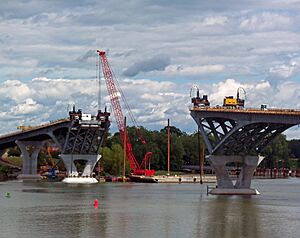Lake Champlain Bridge (1929–2009) facts for kids
Quick facts for kids Champlain Bridge |
|
|---|---|

Previous Champlain Bridge viewed from Chimney Point State Historic Site, Vermont
|
|
| Coordinates | 44°01′57″N 73°25′24″W / 44.03250°N 73.42333°W |
| Carries | Two lanes of |
| Crosses | Lake Champlain |
| Locale | Crown Point, New York and Chimney Point, Vermont |
| Other name(s) | Crown Point Bridge |
| Maintained by | NYSDOT and VTrans |
| ID number | 5521180 |
| Characteristics | |
| Design | Continuous truss (combination of through truss, deck truss, and deck plate girders) |
| Total length | 14 spans totaling 2,184 feet (666 m) |
| Width | 26.1 feet (8.0 m) |
| Longest span | 434 feet (132 m) |
| History | |
| Construction cost | $1,149,032.63 |
| Opened | August 26, 1929 |
| Closed | October 16, 2009 (closure) December 28, 2009 (demolition) |
| Statistics | |
| Daily traffic | 3,510 (2007) |
| Toll | 1929–1987 |
The Champlain Bridge was a long bridge in the United States. It was also known as the Crown Point Bridge. This bridge crossed Lake Champlain between Crown Point, New York and Chimney Point, Vermont.
The bridge opened in 1929. At first, people had to pay a small fee, called a toll, to cross it. These tolls were removed in 1987. The bridge was closed in 2009 because it was no longer safe. It was then taken down using explosives later that year. A new bridge was built in its place, which opened in 2011.
This bridge was one of only two bridges that connected New York and Vermont across Lake Champlain. Other ways to cross the lake included ferry boats. The Champlain Bridge linked NY 185 in New York to VT 17 in Vermont. Both the New York and Vermont transportation departments worked together to take care of the bridge.
Contents
About the Champlain Bridge
The Champlain Bridge was located about 12 miles (19 km) north of Ticonderoga, New York. It was also about 32 miles (51 km) south of Burlington, Vermont. It connected two important roads, NY 185 and VT 17.
This bridge was special because it was one of only two places where cars could drive across Lake Champlain. The other bridge is much further north, near the border with Canada.
History of the Bridge
Building and Closing the Bridge
The Champlain Bridge first opened on August 26, 1929. It was one of the first bridges of its kind in the country. It used a special design called a "continuous truss" which made it very strong. For many years, people paid a toll to cross it, but this stopped in 1987.
In 1991, the bridge was repaired. Workers replaced the road surface and railings. They also repainted the steel parts and fixed the supports.
In 2007, officials from New York and Vermont started planning for the bridge's future. They thought about fixing it again or building a new one. However, in 2009, an inspection showed a big problem. Two of the bridge's main support piers were not safe. Because of this, the bridge had to close to all traffic on October 16, 2009. Engineers were worried the bridge could suddenly break.
What Happened After the Closure?
Closing the bridge caused problems for people and businesses nearby. Commuters had to drive much longer routes. Local shops and restaurants saw fewer customers.
Ferry services became very busy. One ferry south of the bridge was overwhelmed. Another ferry north of the bridge had to work longer hours. Even with help from New York state, these ferries couldn't carry everyone. A special ferry service was even started right where the bridge used to be. This helped people cross the lake for free.
Taking Down and Replacing the Bridge
On November 9, 2009, officials announced that the bridge could not be fixed. It had to be taken down. The bridge was removed using controlled explosives. This happened on December 28, 2009.
A new bridge was then designed and built. Construction began in June 2010. The new bridge opened to traffic on November 7, 2011. It now connects New York and Vermont, just like the old Champlain Bridge once did.
See also
- List of bridges documented by the Historic American Engineering Record in New York (state)



